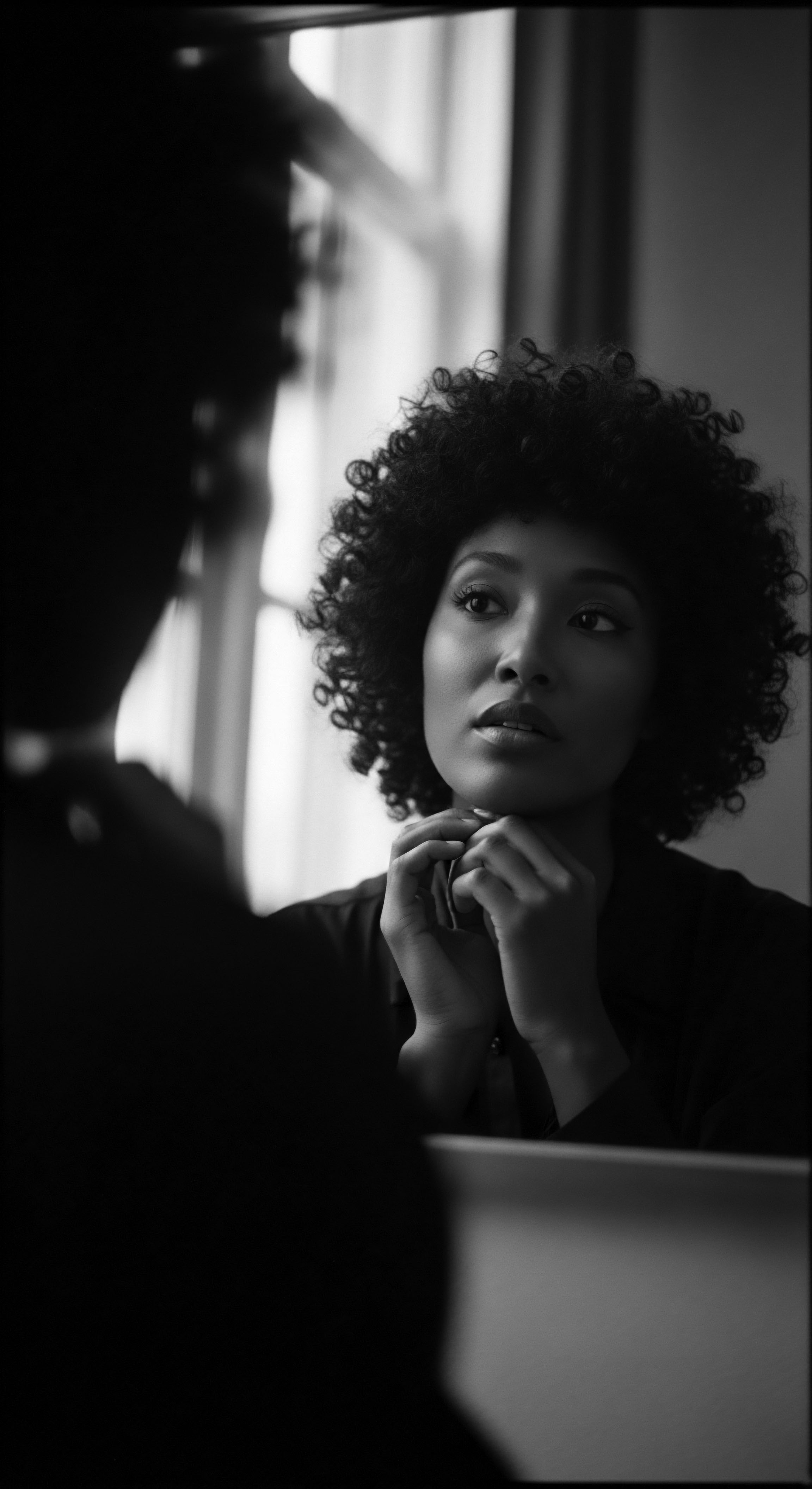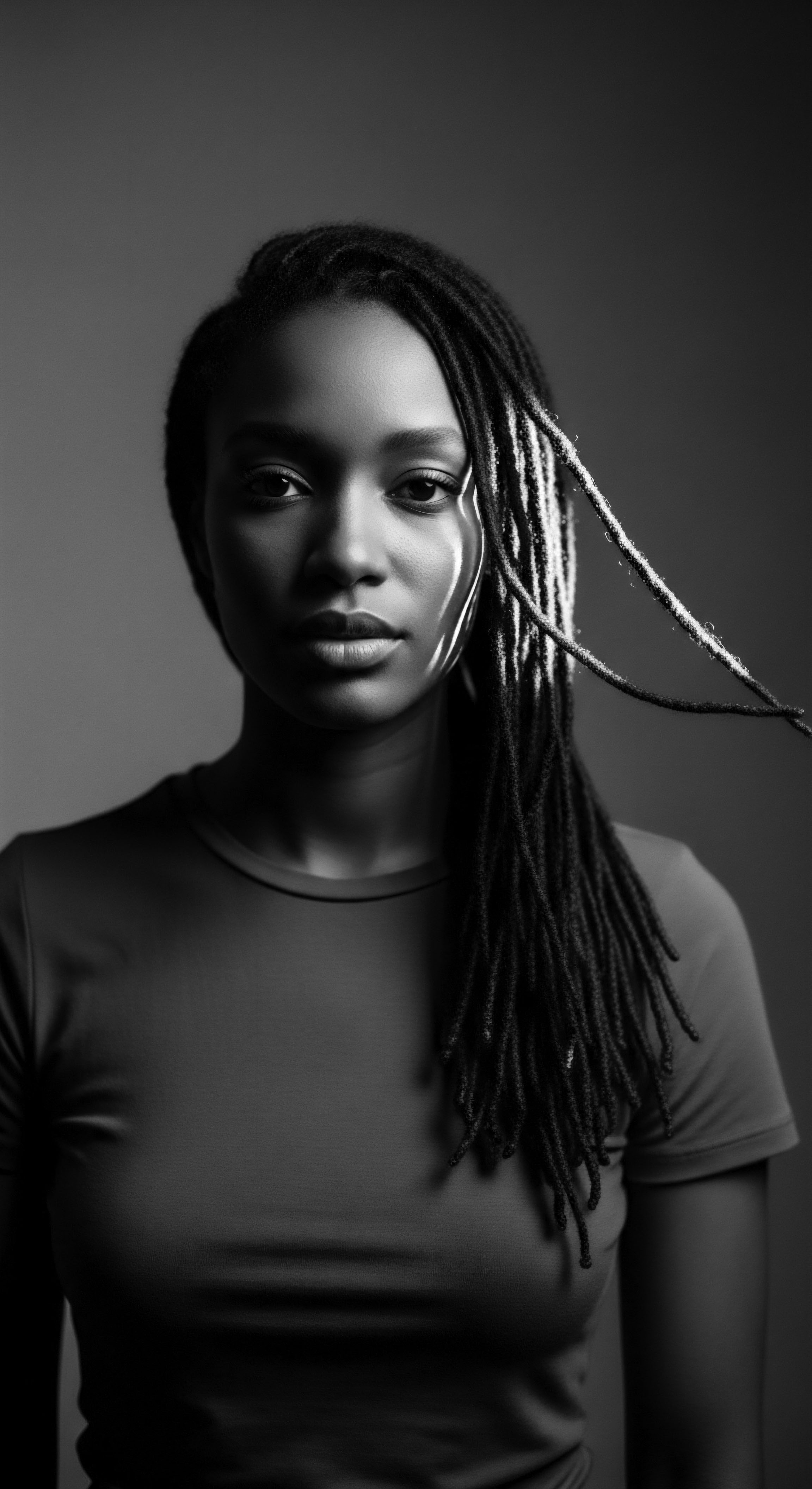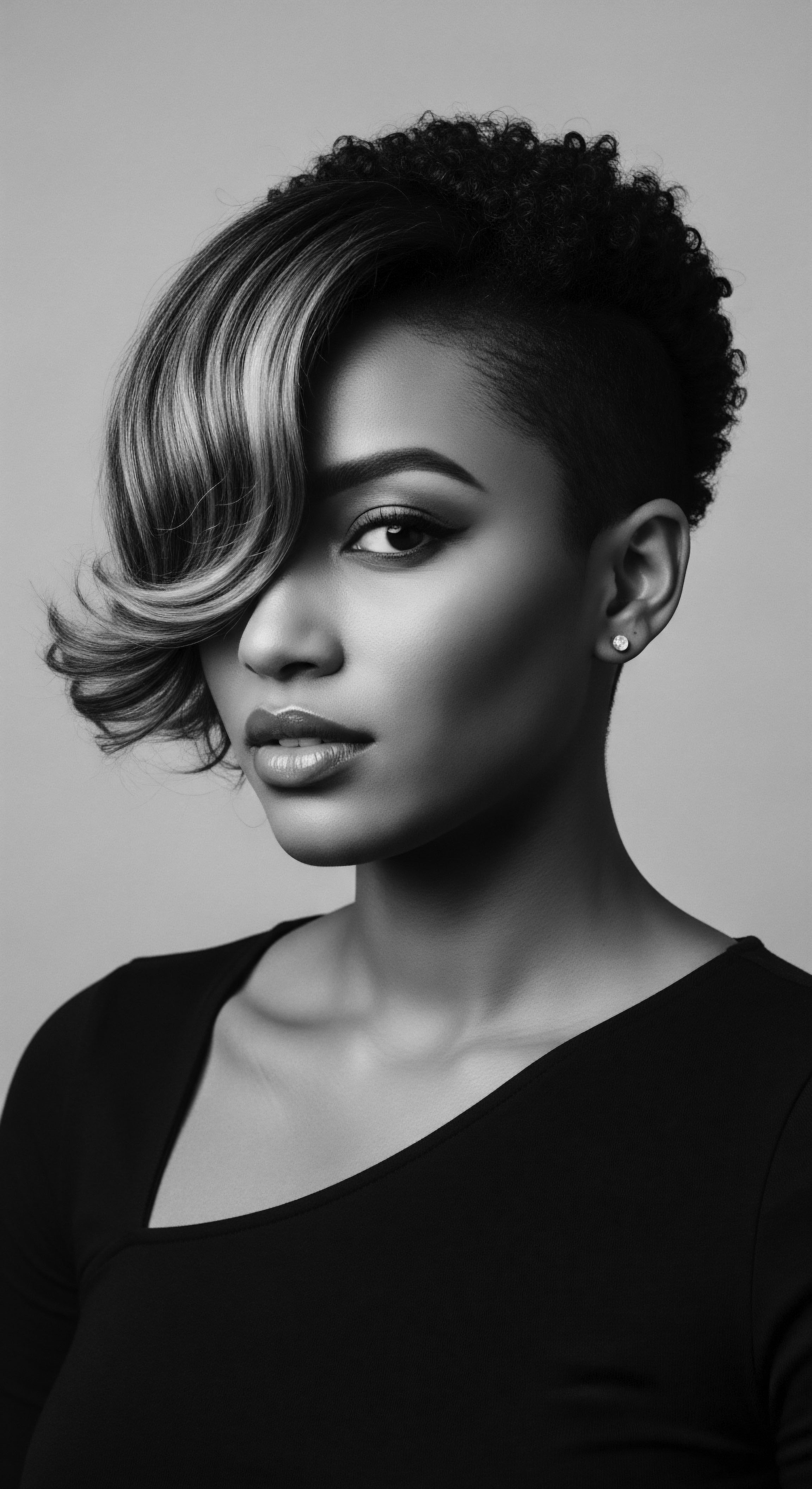
Roots
For those who wear their coiled crowns and textured manes as living declarations of ancestry, the whisper of dry scalp and the ache of irritation are discomforts that reach beyond the superficial. These experiences touch upon a deeper lineage, a historical connection to hair care practices shaped by environment, wisdom, and survival. Our hair, in all its glorious variations of curl and coil, possesses a unique architecture, often requiring generous moisture and gentle handling.
It stands as a testament to resilience, a story passed down through generations, often in whispers of home remedies and communal care. This exploration honors the legacy of those who first understood the intimate relationship between earth’s bounty and scalp well-being, seeking comfort and vitality in ancestral plant oils.

Textured Hair’s Ancient Canvas
To truly understand how ancestral plant oils soothe and nourish, one must first appreciate the inherent characteristics of textured hair itself. Its distinct helical structure, a spiral staircase of keratin, dictates its interaction with moisture. Each bend and twist in a strand creates points where the cuticle may lift, allowing precious hydration to escape more readily than in straighter hair types.
This structural reality, combined with fewer sebaceous glands on the scalp in some individuals or differing sebum distribution, often leads to an inclination toward dryness. Our ancestors, acutely aware of these needs through generations of observation, did not possess microscopes to gaze upon the cuticle, yet their practices spoke to an intuitive understanding of biology and climate.
The lexicon of textured hair, too, is a living artifact of its heritage. From the terms used to describe curl patterns – think of the tight, resilient coils of 4C hair or the gentle waves of 3A – to the language of protective styles like cornrows and locs, each word carries weight, a cultural resonance. Understanding these distinctions becomes important because different textures may absorb and react to oils in unique ways, a lesson our forbears learned through trial and careful observation. The very methods of classification, while sometimes fraught with modern bias, stem from attempts to categorize and care for this diverse spectrum of hair types, reflecting a long-standing desire to provide tailored care.
Ancestral wisdom regarding hair and scalp care was often a direct, intuitive response to the intrinsic needs of textured hair, passed down through generations.

The Genesis of Scalp Care
Hair growth, a continuous cycle of life and renewal, is deeply tied to the health of the scalp. A dry, irritated scalp signals disquiet at the very source of hair’s vitality. In ancient communities, environmental factors played a dominant role in shaping hair health. Arid climates, sun exposure, and daily activities meant constant exposure to elements that could strip moisture and cause discomfort.
The ancestral plant oils emerged from this context, not as mere cosmetics, but as essential remedies for survival and comfort. They served as balms, offering protection against the harsh sun, repelling insects, and maintaining a comfortable scalp environment, all while contributing to the overall strength of the hair itself.
Historically, nutritional factors also influenced hair and scalp conditions. Diets rich in certain plant-based fats and proteins would inherently provide some internal nourishment for hair. The external application of nutrient-dense plant oils complemented this, providing direct relief and support. The wisdom of these traditions, rooted in deep ecological knowledge, recognized the interconnectedness of diet, environment, and physical well-being.

Ritual
The application of ancestral plant oils for textured hair extends beyond simple cosmetic use; it forms a ritual, a connection to traditions of care and community that have spanned millennia. This practice, often a tender act passed from elder to youth, speaks to a heritage of nurturing and resilience. It is in these moments of gentle massage and fragrant application that the science of botanicals meets the soul of a strand, a silent conversation between past and present.

Oils That Whisper Heritage into Hair
A host of plant oils, each with its own story and properties, rose to prominence in ancestral hair care practices. These botanical treasures, often sourced from local flora, became cornerstones of traditional regimens designed to combat dryness and soothe scalp irritation inherent to textured hair.
- Castor Oil ❉ From the seeds of the castor plant, this thick, viscous oil holds a significant place in the historical care of textured hair across various cultures. Ancient Egyptians, for instance, were pioneers in using castor oil for its moisturizing and strengthening properties, often incorporating it into hot oil treatments to nourish the scalp and hair follicles (Arab News, 2012; Hair Care Secrets of the Past, 2024). In West Africa and the Caribbean, particularly Haitian and Jamaican communities, black castor oil, processed through roasting the beans, gained renown for its rich ricinoleic acid content, which contributes to its deep penetration and ability to lock in moisture, reducing dryness and soothing the scalp.
- Shea Butter ❉ Sourced from the nuts of the African shea tree, this butter is a staple in West African hair and skin care. It is known for its healing properties, soothing the scalp and skin. Rich in vitamins A, E, and F, shea butter provides essential nutrients, deeply moisturizing and offering anti-inflammatory benefits to calm irritation.
- Coconut Oil ❉ A ubiquitous presence in many tropical regions, coconut oil has been a beloved component of hair care rituals across South Asia, Africa, and the Caribbean for centuries. Its low molecular weight and linear structure allow it to penetrate the hair shaft, reducing protein loss and providing deep moisture that combats dryness and flakiness. In some traditional Ayurvedic practices, coconut oil is chosen for its cooling properties.
- Argan Oil ❉ Hailing from Morocco, argan oil, often called “liquid gold,” has been used for centuries for its reparative and beautifying properties. It is rich in vitamin E and essential fatty acids, helping to maintain the scalp’s natural moisture level and soothing inflammation.
- Jojoba Oil ❉ While indigenous to North America, particularly the Sonoran Desert, jojoba oil has found resonance within Black communities due to its molecular similarity to the scalp’s natural sebum. This unique characteristic makes it an exceptional moisturizer and scalp hydrator, addressing dryness and irritation effectively without leaving a greasy residue. Its rise in popularity coincided with the natural hair movement of the 1970s, where Black women embraced indigenous oils as an act of cultural authenticity.
- Batana Oil ❉ Extracted from the nuts of the American palm tree, native to Central and South America, batana oil has been used for centuries by the Miskito people of Honduras, who call themselves the “people of beautiful hair.” It is rich in fatty acids and antioxidants, known for nourishing and strengthening the hair and scalp, and providing relief from itching and dryness.

Techniques That Cherish
The simple act of applying oil was rarely simple in ancestral contexts. It was often paired with specific techniques that amplified the oil’s benefits, becoming an integral part of hair styling and maintenance:
Scalp Massage ❉ This practice was, and remains, fundamental. Massaging oils into the scalp helps distribute the product, stimulate blood circulation, and gently exfoliate, ensuring that hair follicles receive vital nourishment and alleviating dryness directly at the source. This physical connection to one’s scalp serves as a direct intervention against irritation.
Hot Oil Treatments ❉ Warming the oils before application, a common ancestral practice, enhanced their penetration into the hair shaft and scalp. This warmth opens the hair cuticles, allowing the beneficial compounds to seep more deeply, offering greater relief from dryness and improving overall hair health. Such treatments were not merely about product delivery; they were moments of restorative comfort, a time for softening, soothing, and preparing the hair for styling or rest.
A striking example of how ancestral knowledge addressed textured scalp irritation comes from the Miskito people of Honduras . For hundreds of years, these indigenous communities, often referred to as the “Tawira” or “people of beautiful hair,” have relied upon Batana Oil. This potent oil, derived from the nut of the American palm tree (Elaeis oleifera), was not just a styling aid.
It was a foundational component of their holistic hair care, credited with addressing dryness, promoting growth, and restoring overall scalp health. The consistent use of Batana oil by generations of Miskito people demonstrates an enduring, community-wide commitment to ancestral remedies that directly counteracted scalp ailments common to their textured hair, a practice passed down through oral tradition and lived experience (Formula Botanica, n.d.; RA Cosmetics, n.d.).
The historical use of specific plant oils intertwined with cultural practices provided both physical relief and a deeper connection to community and heritage for textured hair.
| Plant Oil Castor Oil |
| Ancestral Origin/Community Ancient Egypt, West Africa, Caribbean (Haitian, Jamaican) |
| Traditional Scalp Benefit for Textured Hair Moisturizing, strengthening hair follicles, reducing dryness, stimulating blood flow. |
| Plant Oil Shea Butter |
| Ancestral Origin/Community West Africa |
| Traditional Scalp Benefit for Textured Hair Healing properties, soothing irritation, deep moisturizing. |
| Plant Oil Coconut Oil |
| Ancestral Origin/Community South Asia, Africa, Caribbean |
| Traditional Scalp Benefit for Textured Hair Deep moisture, reducing protein loss, combating dryness and flakiness. |
| Plant Oil Argan Oil |
| Ancestral Origin/Community Morocco |
| Traditional Scalp Benefit for Textured Hair Maintaining scalp moisture, soothing inflammation, repairing dryness. |
| Plant Oil Jojoba Oil |
| Ancestral Origin/Community Indigenous American cultures, adopted by Black communities |
| Traditional Scalp Benefit for Textured Hair Mimicking natural sebum, exceptional moisturizing, hydrating scalp, addressing dryness and breakage. |
| Plant Oil Batana Oil |
| Ancestral Origin/Community Miskito people of Honduras (Central/South America) |
| Traditional Scalp Benefit for Textured Hair Nourishing, strengthening scalp, alleviating itching and dryness, supporting overall scalp health. |
| Plant Oil These oils represent a collective ancestral understanding of botanical properties for maintaining scalp vitality, especially for hair with unique needs. |

Relay
The journey from ancestral practices to modern understanding reveals a remarkable convergence ❉ contemporary science often validates the deep wisdom embedded in traditional hair care. The plant oils our ancestors utilized were not simply chosen at random; their efficacy for alleviating scalp irritation and dryness in textured hair is rooted in their unique biochemical compositions. This section delves into the intricate mechanisms through which these heritage oils offer relief, bridging ancient observation with current scientific explanation.

The Biochemical Comfort of Heritage Oils
Why do these particular plant oils bring comfort to an irritated, dry scalp? The answer lies in their molecular architecture. Many ancestral oils are rich in specific fatty acids, vitamins, and antioxidants that directly address the challenges textured hair often faces.
For instance, the high concentration of Ricinoleic Acid in castor oil allows it to penetrate the scalp deeply, where it can moisturize and potentially act against microbial issues that contribute to irritation. This capacity for deep delivery is paramount for bringing lasting relief to parched skin.
Consider the anti-inflammatory properties present in many of these oils. Scalp irritation often involves inflammation, a biological response to stress or damage. Oils rich in compounds like tocopherols (Vitamin E) and various phenolic compounds found in argan, shea, and coconut oils can help calm this response. Scientific literature indicates that various essential oils possess anti-inflammatory activity, influencing pathways that regulate the body’s inflammatory responses.
This explains the soothing sensation and reduction in redness often experienced with consistent use of these traditional oils. For example, yarrow extracts, used by Native American ancestors, have shown significant anti-inflammatory properties, providing a foundation for their use in soothing irritated skin and scalp conditions. Similarly, argan oil, with its omega-6, omega-9, and tocopherol content, helps strengthen hair and maintain scalp moisture.

How Do Ancestral Oils Restore Scalp Balance?
The skin of the scalp, like skin elsewhere on the body, functions best when its protective barrier is intact and balanced. For textured hair, this barrier can be compromised by a lack of natural oils, harsh cleansing agents, or environmental stressors. Ancestral plant oils step in as potent allies. Many act as emollients, creating a protective layer that seals in moisture and reduces trans-epidermal water loss.
Coconut oil, for example, is noted for forming a coating over the hair shaft, trapping moisture inside and detangling strands. This barrier support is crucial for preventing the cycle of dryness and subsequent irritation.
Furthermore, some oils possess antimicrobial and antifungal qualities. Conditions like dandruff, often linked to scalp irritation, can be exacerbated by microbial imbalances. The lauric acid in coconut oil, for instance, exhibits antibacterial and antifungal activity. Similarly, tea tree oil, an ancient remedy used by indigenous peoples of Australia, has antifungal, antimicrobial, antiseptic, and anti-inflammatory properties, making it effective against dandruff and dry scalp.
West African palm kernel oil, also considered a “batana oil” in some contexts, possesses natural anti-inflammatory and antibacterial properties that help keep the scalp healthy and reduce flakiness. These properties address underlying factors that contribute to scalp discomfort, rather than simply masking symptoms. The multifaceted nature of these ancestral oils speaks to a holistic understanding of scalp health that predates modern laboratories.
The efficacy of ancestral plant oils for textured scalp concerns rests upon their rich biochemical profiles, offering deep moisture, anti-inflammatory compounds, and antimicrobial protection.

Modern Science, Ancient Wisdom
The continuity of traditional hair oiling practices across diverse Black and mixed-race communities, despite historical disruptions, testifies to their inherent value. Modern scientific inquiry does not dismiss these practices but rather provides a deeper articulation of their effectiveness. The understanding of how specific fatty acids contribute to barrier function, or how particular plant compounds modulate inflammatory pathways, offers a scientific language to explain what generations already knew through observation and inherited wisdom. This interplay creates a powerful narrative, where the past informs the present, guiding our continued care for textured hair with a reverence for its heritage and its unique biological needs.
The cultural ritual of oiling, often a moment of connection and care within families, gains a new layer of appreciation through this validated scientific lens, reinforcing its significance as a truly integrated wellness practice. It is a testament to the enduring intelligence of traditional knowledge systems, where the “Soul of a Strand” finds its sustenance in both memory and molecules.
- Ricinoleic Acid in Castor oil ❉ This unique fatty acid is responsible for its moisturizing qualities and its potential to nourish hair follicles and protect against microbial imbalances on the scalp.
- Lauric Acid in Coconut oil ❉ A saturated fatty acid that can penetrate the hair shaft, reducing protein loss and exhibiting antibacterial and antifungal activity vital for scalp health.
- Tocopherols and Phenolics in Argan, Shea, and Marula oils ❉ These powerful antioxidants (like Vitamin E) and compounds contribute anti-inflammatory effects, soothing irritated scalp tissue and promoting overall scalp well-being.

Reflection
The quiet persistence of ancestral plant oils in caring for textured hair is more than a testament to their physical efficacy. It is a profound meditation on the resilience of cultural memory, a living archive whispered through touch and scent across generations. Each drop of oil, whether it be Haitian black castor, West African shea, or South American batana, carries the weight of a shared heritage.
It speaks of survival, ingenuity, and a deep, abiding connection to the earth’s healing gifts, even in the face of immense historical hardship. These practices, once acts of necessity, have become enduring symbols of self-acceptance and cultural affirmation.
The journey of textured hair, from its inherent biological wonders to its profound cultural significance, finds its story deeply intertwined with these botanical allies. They have offered solace for dry scalps, calmed irritation, and provided a canvas for expressions of identity that defy erasure. The wisdom gleaned from these ancestral practices reminds us that true care extends beyond the superficial; it nourishes the roots, honors the past, and strengthens the spirit of every strand, ensuring that the legacy of textured hair continues to shine, unbound and vibrant, into every tomorrow.

References
- Arab News. “The secret of ancient Egyptian beauty.” 2012.
- Dube, Albert, et al. “Cosmetopoeia of African Plants in Hair Treatment and Care ❉ Topical Nutrition and the Antidiabetic Connection?” MDPI, 2023.
- “Hair Care Secrets of the Past ❉ What Our Ancestors Used for Healthy Hair.” 2024.
- Nkwate, Jeanette. “Are We Really Not Supposed To Use Oils On Natural Hair?” Refinery29, 2022.
- Ollennu, Amerley. “Here’s why hair oiling is the ancient ritual worth adopting.” Etre Vous, 2022.
- Roy, Raktim, et al. “Hair Oils ❉ Indigenous Knowledge Revisited.” PMC, 2010.
- Sharma, Rajendra P. and Amita Singh. Indian Medicinal Plants ❉ An Illustrated Dictionary. Springer, 2014.
- Smiljkovic, Milica, et al. “Anti-Inflammatory Properties of Plants from Serbian Traditional Medicine.” MDPI, 2023.
- “The Evolution of Black Hair Products ❉ A Journey from Homemade Remedies.” Safo Hair, 2024.
- “The Mane Choice Ancient Egyptian Anti-Breakage Hair Oil, 8 oz, Lightweight Natural Hair Oil, Strengthens & Protects with Biotin & Vitamins – Paraben & Sulfate Free.” Amazon.com, n.d.
- “The Untold Story of Jojoba Oil in Black Beauty.” BeautyMatter, 2025.
- “Traditional African Secrets For Long And Healthy Hair.” Africa Imports, n.d.
- “What can we learn from our ancestors when it comes to hair growth.” hairmetto, 2020.
